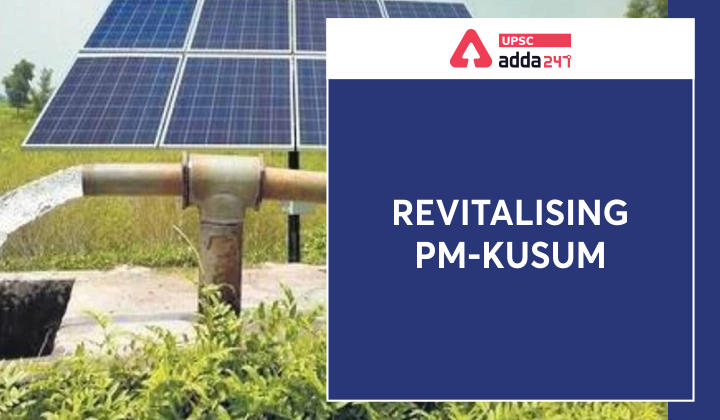Table of Contents
PM-KUSUM- Relevance for UPSC Exam
- GS Paper 2: Government policies and interventions for development in various sectors and issues arising out of their design and implementation.
- GS Paper 3: Environment- Conservation, environmental pollution and degradation.
PM-KUSUM- Context
- The Union Minister of Power, New and Renewable Energy recently reviewed the progress of the PM-KUSUM scheme and reaffirmed the government’s commitment to accelerating solar pump adoption.
National Financial Reporting Authority- Background, Formation and Key Functions
PM-KUSUM- Revitalizing PM-KUSUM
- About: PM-KUSUM Scheme was in 2019, PM-KUSUM and aims to help farmers access reliable daytime solar power for irrigation, reduce power subsidies, and decarbonize agriculture.
- PM-KUSUM provides farmers with incentives to install solar power pumps
- and plants in their fields.
- Various Models: The farmers can use one of three deployment models:
- Off-grid solar pumps,
- Solarised agricultural feeders
- Grid-connected pumps
FASTER system of Supreme Court
PM-KUSUM- Associated Challenges
- The effective and efficient roll-out of the PM-KUSUM Scheme was hindered by the following factors-
- Pandemic-induced disruptions,
- Limited buy-in from States, and
- Implementation challenges
- Unmet targets: Off-grid pumps have been the most popular, but the nearly 2,80,000 systems deployed fall far short of the scheme’s target of two million by 2022.
- Barriers to adoption include limited awareness about solar pumps and farmers’ inability to pay their upfront contribution.
- Issues with the model of the grid-connected pumps: obstacles to their adoption include concerns about
- Their economic viability in the presence of high farm subsidies and
- Farmers’ potential unwillingness to feed in surplus power when selling water or irrigating extra land is a more attractive prospect.
Cyclone Gulab- Key Features and Naming of Cyclones
PM-KUSUM- Way Forward
- Promote Solarised agricultural feeders & Grid-connected pumps Model: They allow farmers to earn additional income by selling solar power to discoms, and discoms to procure cheap power close to centres of consumption.
- Extend the scheme’s timeline beyond 2022: this would allow discoms to align the scheme with their power purchase planning.
- Presently, most Indian discoms have a surplus of contracted generation capacity and are wary of procuring more power in the short term.
- Create a level playing field for distributed solar plants: discoms often find utility-scale solar cheaper than distributed solar (under the scheme) due to the latter’s higher costs and the loss of locational advantage due to waived inter-State transmission system (ISTS) charges.
- We need to address counter-party risks and grid unavailability risks at distribution substations, standardize tariff determination to reflect the higher costs of distributed power plants and do away with the waiver of ISTS charges for solar plants.
- Streamline land regulations through inter-departmental coordination: Doing so will help reduce delays in leasing or converting agricultural lands for non-agricultural purposes such as solar power generation.
- Support innovative solutions for financing farmers’ contributions: As many farmers struggle to pay 30-40% of upfront costs in compliance with scheme requirements.
- Out-of-the-box solutions like Karnataka’s pilot of a farmer-developer special-purpose vehicle to help farmers install solar power plants on their farms.
- This type of out-of-the-box thinking can be replicated by other states as well.
- Extensively pilot grid-connected solar pumps: Adopting solutions like smart meters and smart transformers and engaging with farmers can build trust. But piloting the model under different Agro-economic contexts will be critical to developing a strategy to scale it up.
IPCC report’s Sixth Assessment Report
Conclusion
Successful implementation of this scheme can generate thousands of jobs, reduce the carbon footprint of agriculture, and result in oil import savings.




 TSPSC Group 1 Question Paper 2024, Downl...
TSPSC Group 1 Question Paper 2024, Downl...
 TSPSC Group 1 Answer key 2024 Out, Downl...
TSPSC Group 1 Answer key 2024 Out, Downl...
 UPSC Prelims 2024 Question Paper, Downlo...
UPSC Prelims 2024 Question Paper, Downlo...
